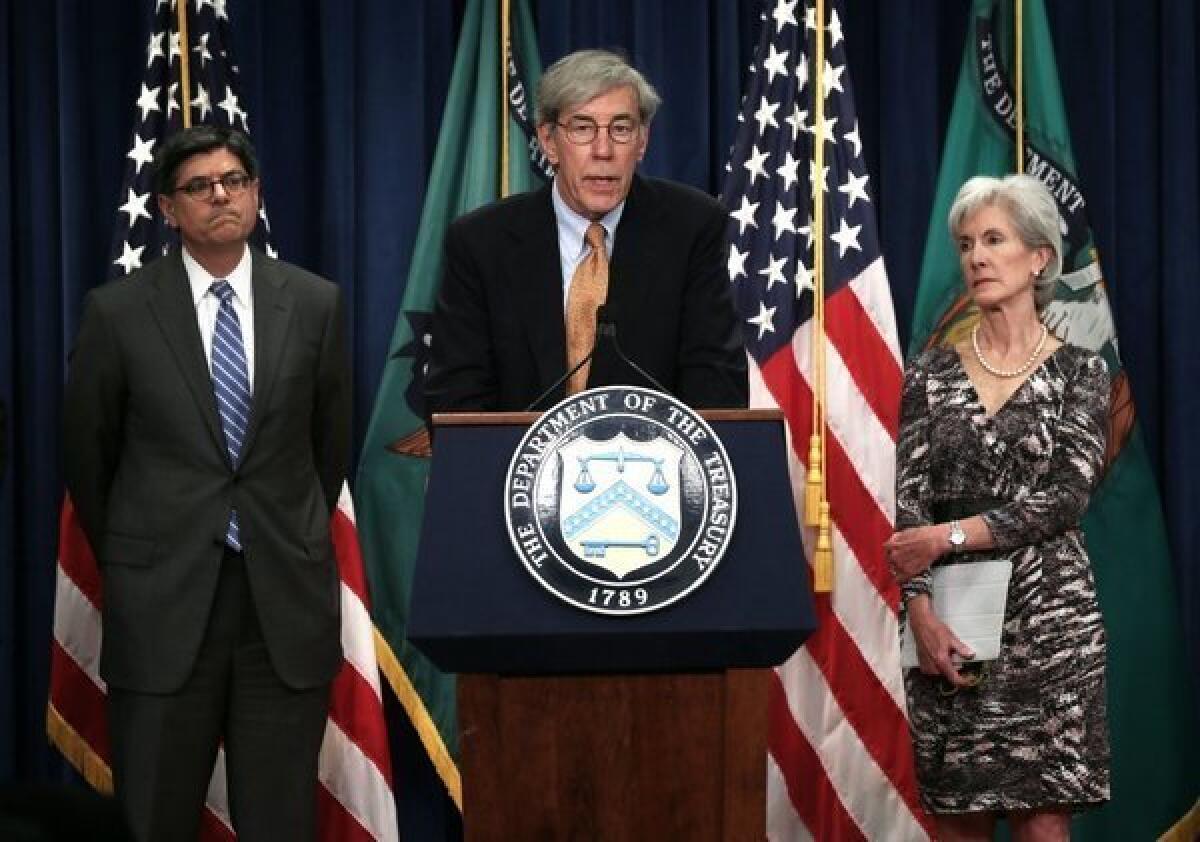Five ways to think about the new Social Security report

- Share via
The release of the annual trustees reports for Social Security and Medicare has generated some of the most overheated hand-wringing about the health of these two crucial programs in recent years, largely because the economic slump has made them look weaker than they may be over the long term.
The reports were released Friday, and so far the reaction has been muted -- possibly because both reports have more good news, or at least neutral news, than bad. For example, the Medicare trustees project an improvement in the depletion date for the hospital insurance trust fund -- that’s Medicare Part A -- by two years, to 2026. Some of that improvement is due to changes coming from the Affordable Care Act, which is expected to tamp down the rate of increase in hospital costs over the coming decades.
The Social Security trustees report has traditionally garnered most of the attention on these occasions, so here are five important points raised by the report and the trustees’ statements during their news conference Friday.
1. There’s still no reason for panic in “fixing” Social Security. The projected depletion date for the Social Security trust fund is still 2033, the same as it was in last year’s report. If the projection comes true, there then would be be enough money coming into the system from the payroll tax and other revenue sources to cover about 77% of currently scheduled benefits.
But that’s 20 years off, and projections at that range are inherently uncertain. “Only time will tell how accurate or inaccurate our projections turn out to be,” said public trustee Charles Blahous, making a point that is almost always overlooked in the Social Security debate. But Blahous is the most hawkish trustee, and he segued instantly into an appeal that Congress act to close the projected deficit now. He did this by contrasting the cost of doing so today versus waiting until 2033.
But of course those aren’t the only two choices. It makes sense to wait at least several years for two reasons: The risk of making irrevocable but unnecessary changes in the program become higher with haste; and the scale of the problem to be solved -- if there is one -- will become clearer as time passes. The likelihood is that Social Security’s fiscal position will improve as the economy does, which leads us to the next point.
2. The health of the economy matters. Social Security’s finances are very sensitive to economic growth and wages; at least part of the reason that Social Security’s finances stabilized in the last year was the resumption of economic growth and projections that it will continue. As economist Dean Baker of the Center for Economic and Policy Research observed after the reports’ release, the trustees’ assumption imply that the average real wage in 2045 will be 55% higher than it is today or $68,000 in today’s dollars.
“A robust economy means stronger Social Security and Medicare systems,” said acting Labor Secretary Seth Harris, also a trustee. he pointed out that increasing the federal minimum wage and indexing it to inflation, expanding the nation’s labor force, and enacting immigration reform “to bring millions of people out of the shadows” will all improve the programs’ health.
3. The disabiity program needs fixing now. Here’s where the urgency lies: The disability insurance trust fund is projected to become depleted in 2016, after which the money coming in will cover only 80% of scheduled benefits. That strikes at some of the neediest Social Security beneficiaries and their families. The disability program has long been the most underfunded element of Social Security, and this deadline has been anticipated for years. In the past, similar shortfalls have been closed by reallocating payroll tax revenues and other income from the retirement to disability. That’s an appropriate short-term fix, but something more permanent is needed now.
4. Social Security’s portion of the economy will plateau. Big numbers always scare people, and multi-trillion-dollar estimates of Social Security’s deficit projected out to infinity are terrifying on a Godzilla-esque scale. The trustee reports show that the cost bulge caused by baby-boomer retirements is finite -- moreover, that it’s eminently manageable within the context of a growing U.S. economy. Through 2035, costs will increase faster than income because of the retirement surge. But from 2035 through 2050 that trend reverses because the baby-boomer retirements get supplanted by retirements of the low-birth-rate generations that followed.
In relation to the overall economy, Social Security will rise from 5.1% of gross domestic product today to about 6.2% in 2035, then fall to 6% by 2050. Thereafter it remains in a tight range of 6% to 6.2% through at least 2087, the limit of current projections. Forecasts of an “unsustainable” increase in the nation’s retirement burden, that staple of fiscal panic-mongers, clearly are off-target.
5. This is the most dependable and important retirement program we have. Social Security sustains 40 million retirees and their dependents, among the 58 million beneficiaries -- and provides more than half the income for two-thirds of them. Workplace-defined contribution plans such as 401k’s, which have replaced the defined benefit pensions that once spelled retirement security for American workers, are no substitute. That’s obvious from the whipsawing that 401k nest eggs have taken in the market over the last few years.
The nation can afford Social Security -- not only can, but must.
Related:
The ripoff at the heart of the “chained CPI”
The truth about the disability “crisis”
The five biggest lies about Social Security and Medicare
More to Read
Inside the business of entertainment
The Wide Shot brings you news, analysis and insights on everything from streaming wars to production — and what it all means for the future.
You may occasionally receive promotional content from the Los Angeles Times.











